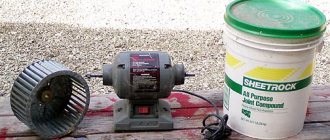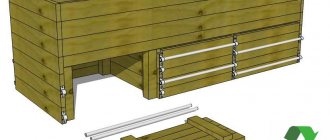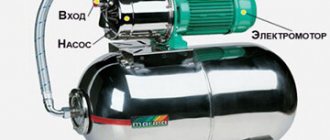Temperature in the cellar in summer
Exceeding these parameters leads to spoilage of products, as well as to the development of various fungi and pathogens in conditions of high humidity.
Recommended indicators in summer and winter are practically the same. So, with a stable summer ambient temperature of 25-30 degrees, the optimal values for an underground cellar will be 5-7 degrees.
That is, it is natural that when the temperature outside the storage facility rises, the air inside it also heats up. The same applies to storage facilities located under residential buildings. Along with heating the house, the air in the cellar warms up.
There is no doubt that all thermal insulation work and adjustment of the functioning of the ventilation system should be carried out at the construction stage. However, it happens that the basement has already been built, and you need to take emergency measures aimed at reducing the indicators inside it.
In this case, you can use both natural and artificial methods. For example, it is recommended to create a draft by opening doors (hatch) and vents; For quick cooling, you can resort to using a fan or air conditioner. The so-called glaciers - containers filled with snow or ice and located on the floor or under it - will also help with cooling.
Folk methods for regulating temperature in summer have long been known. We are talking about glaciers - containers filled with ice or snow. Their volume depended on what level of cooling was required. Such devices were installed on the basement floor.
Today we can reduce the heat by using regular plastic bottles filled with ice. Of course, this method is only suitable for small underground storage facilities. The same bottles, filled with snow mixed with table salt, can be buried in a small hole at the bottom in the spring, thus providing the necessary regime in the summer.
We make a portable version
The first step is to choose a base that is suitable in shape and size. It all depends on what kind of bag you need: small or spacious. It is better to choose a product with a zipper. This design better maintains internal temperature.
Choose a comfortable bag: beach, sports, travel, spacious shopper.
The main part of the product is heat-reflecting material, which will help maintain the desired temperature inside the container. Choose moisture-resistant material. Then the outer cover will not get wet if there is slight condensation inside.
An excellent solution is foil isolone. This is foamed polyethylene covered with metallized foil. It can be one-sided or two-sided. The latter holds the temperature better. Products in such containers will remain chilled longer. There is also an isolon option, where one side is covered with adhesive material. It is easier to make a heat-resistant lining from it. It is more convenient to use, but it costs more. Take isolon in reserve. The extra centimeters can be cut off, but adding the missing ones will be more difficult.
Another important material for creating a DIY refrigerator bag is tape. You will use it to glue the joints of the lining so that it retains the temperature better. Choose regular double-sided tape, use foil tape. The latter allows less heat to pass through the joints and provides additional temperature retention.
We assemble the product with our own hands
After you have selected the necessary materials, it is time to prepare the base for the future heat-resistant lining and shape the product.
- Make a pattern from foil-isolon. To do this, take measurements from the selected bag. Remember: the lining should be smaller in size than the main container so that it fits easily into the product. Optimally, subtract 5 cm from the external dimensions of the cover and use it to make a pattern from the blank.
You can make a single pattern for the entire product. Consider the dimensions of the side walls, bottom, top, front, and back of the outer cover. If it is difficult to calculate what a solid piece will look like, cut the material for each section separately. Later you will glue them together with tape.
- According to the markings, carefully cut the required amount of material.
- Fold the resulting workpiece, forming a frame of a heat-resistant lining from it. The sides will hold their shape better if you grab them with threads or a stapler.
- Insulate the joints with tape. Walk along the outer and inner sides so that there are no gaps left. This way the product will better maintain temperature.
- Insert the resulting lining inside the selected bag. Fill the free space between the walls with batting, padding polyester, and scraps of an old blanket. This way the product will hold its temperature better.
Useful tips for making
If you use one-sided isolon when making a thermal bag with your own hands, make sure that the foil is the outer layer of the lining.
It is easier to form a lining from isolon with an adhesive backing. Place the material close to the inner surface of the container. Carefully removing the protective layer, spread the foil-isolon over the fabric. If between sections of thermal material there is
The thermal insulation base must have a lid to keep the coolness better. Make the lid a little larger than the base, then you can simply tuck it into the walls of the frame. Or add adhesive strips and a zipper.
To make the frame better hold its shape, insert foil-isolon plates into the sides. Glue them with tape. Also, cuts from isolon can be used as dividing elements, forming separate sectors for storing food inside the container.
How to make a usb refrigerator
When working with a computer, especially in the heat, you want to have chilled drinks on hand. A USB refrigerator can solve the problem. It is usually small in size, no more than a couple of cans of beer or drinks can be placed in it.
Popular articles Decorative topiary
To become the owner of such a useful gadget, you need to purchase:
- Thermoelectric converter: this usually means a Peltier element; When a device is supplied with direct current, one of the sides gives off temperature, and the other, on the contrary, heats up; buy in a computer salon, on the radio market;
- Two radiators;
- Thermal paste.
There is a Peltier element in the computer - it is used to cool the processor. Between it and the cooler you can find it in an old computer. The element for the refrigerator is suitable, you just need to clean off the old thermal paste from it. If there is an unnecessary amplifier, then you can remove the radiators from it.
Next, the Peltier element is placed between the radiators. The merger is done using thermal paste. After connecting the USB cable wires to the element, the operation of the resulting device is checked. It is connected to the USB port of the computer - one side should be cooled, the other should be heated.
In order for the device to be converted into a refrigerator, it is placed in the lower part of the case, using it as a base. The body is made of a material that has good thermal insulation. You can use porous plastic; dense foam will do.
The sides, back wall, and top base are cut according to the size of the device and the container in which the drinks are located. Glue them together with superglue. The door can be made transparent - from plexiglass, recessed in a frame made of plastic or foam. Any loops will do. To ensure that the doors close securely, they are equipped with a magnetic clasp.
The refrigerator is ready and can be used to cool a bottle of drink. Some people modd the resulting unit. To do this, print your favorite pictures and web pages on transparent sheets and stick them on the outside of the door on plexiglass. A further improvement of the refrigerator could be the installation of LED lighting inside the chamber.
Some craftsmen place radiators in the upper base, explaining this by the fact that the cold will fall from top to bottom and will cool the drink faster. In addition, the inside of the housing is covered with an additional three layers of aluminum foil, increasing its thermal insulation.
Cooler operating rules
To ensure that the device does not lose its effectiveness, it is important to follow the operating instructions and adhere to the following rules:
- flow-through units cannot be turned on without water (the compressor may fail);
- you need to monitor the water level so that it does not freeze in the tank along with the drink itself, which will also lead to damage to the cooler;
- Ventilation is important for the device so that it does not overheat, so the distance between it and other objects must be at least 1.5 cm;
- Do not exceed the operating mode and overcool the beer; increasing peak loads will lead to excessive foaming.
To avoid problems with the operation of the beer cooler, choose a high-quality device and follow the instructions that come with each unit.
Refrigerator for draft beer and drinks.
Ready-made or custom-made according to your sizes.
The longest shelf life of live beer is achieved at a temperature of +4°С…+7°С. Most often, to maintain a given temperature regime, specialized refrigeration chambers, “coldrooms” and kegerators are used.
carries out projects of any complexity related to the organization of storage conditions for beer in kegs. Individual sizes of refrigeration chambers made of sandwich panels allow them to fit perfectly into the architecture of any room. Our Customers independently (with the consulting support of a personal project manager) choose the appropriate type of unit, size and location of doors, if necessary, complete the chamber with double-glazed windows or hinged/sliding structures with glass; we offer reliable turnkey beer chambers to suit your budget.
If you are “closely familiar” with beer (whether as a seller or as a consumer), then you know very well that good beer must be at the right temperature. And the point here is not only in taste (although it is well known what kind of epithet is bestowed on warm beer): for long-term storage without loss of quality, both canned/bottled and keg beer must be kept in strictly controlled temperature conditions. Thus, if you are planning a business selling beer, then you cannot do without a good refrigeration chamber!
Freezer from an antique refrigerator
This is the simplest and most inexpensive way to quickly achieve your goal. Greater efficiency from the equipment can be expected when there are old models of refrigerators in the “bins”: for example, Polyus, SVYAGA or ZIL will do. In this case, the refrigerator compartment will freeze very well, and there is no need to complain about the reliability of Soviet designs. The work is carried out according to the following algorithm:
- The outside of the unit is covered with foil insulation, the minimum thickness of the material is 5 mm. Dismantle and discard the freezer body.
- Unfold the evaporator: first unscrew the 2 screws located on top, then unbend the antennae. The main requirement is to take care of the two tubes on which it rests. The less these parts bend, the better.
- To protect the device from damage, it is better to release the refrigerant in advance, but such an activity requires special equipment.
- The evaporator is securely attached to the rear wall.
- The thermostat sensor is “hidden” in a vinyl tube, then attached to the evaporator.
If there is an old device, but it is faulty, then only establishing the cause of the breakdown will give an answer about the advisability (or impossibility) of using it in a new capacity. There is one more disadvantage in the “rebirth” of old refrigerators: this is the greater amount of energy that they need to operate, when compared with store-bought models of chambers.
How to disassemble a refrigerator
The first thing you need to take care of when disassembling an old refrigerator is safety. For this reason, before starting work, you should disconnect the device from the electrical supply and only then get down to business.
The general scheme for remodeling the camera includes the following steps:
- Dismantling an old refrigerator. No details need to be thrown away just yet, even if at first glance they seem unnecessary. Most likely, these are the elements you will need when assembling a new camera.
- Removing the evaporator.
- Fixing the evaporator.
- Installing a new temperature sensor.
- Functionality check.
Remember! You need to check how well the converted camera works gradually.
It would be unwise to immediately load the device to the top with products, because it may not work properly, as a result of which everything that was frozen will spoil. In such a case, it is recommended to place only a couple of foods or just bottled water in the chamber. By the level of its freezing, you can determine how well the freezer is working.
You should also know that all refrigerator models are disassembled differently. This is due to the structural features of the devices, as well as the types of installed cooling systems.
If the equipment being converted is inoperable, then when working with it you should handle the tubes very carefully, avoiding their kinks. It is better to release the refrigerant altogether and refill it after reinstalling the system. Of course, this will complicate the process somewhat, but getting a new camera to work is often the only way to do it.
In some cases, a non-working camera requires a preliminary search for the cause of the malfunction. It may also happen that repairing and further reworking the device will simply be pointless.
Important! It should be understood that homemade designs that were made from old refrigerators will require more energy than their new store-bought counterparts. This is justified by the fact that they have lower efficiency.
How to replace cold storage batteries
Special cold accumulators are made for factory cooler bags and household products. These are flat plastic containers with a narrow neck where the cooler is located. By placing such a product in a thermal box, you will keep the food at the desired temperature longer. But it is not necessary to buy special batteries. You can make them yourself. This option will be much cheaper:
Liquid batteries. Use plastic bottles, rubber heating pads, and sealed zip bags. Pour water into a bottle or heating pad and freeze it. And you can put ready-made ice in the bag. To keep the coolant from melting longer, add salt to the water. This way, homemade batteries will last longer.
Gel batteries. The same zip bags and bottles will do here. The liquid is prepared according to the following principle. Dilute salt in water, add gelatin or wallpaper glue. Follow the proportions of water and product specified by the manufacturer. Pour the prepared mixture into a container and freeze it.
It is better to use products from sealed bags. They have an optimal shape and are more convenient to place between products than, for example, bottles with frozen liquid. Such batteries take up less space.
What you can build with your own hands
After the first acquaintance with the “insides” of a typical refrigeration chamber, you can begin to consider the possible range of home-made designs. In this case, it all depends on how much money the owners can afford to spend on making a freezer. There are several options to achieve the goal, but each of them requires its own “individual” set - both materials and equipment. The following can be turned into a refrigerator:
- refrigerators, old but serviceable, or those that can be repaired;
- containers, rooms;
- cellar
Purchasing a ready-made cooling system is necessary when choosing one of the first 2 options. Arranging a cellar chamber is a more labor-intensive method. There are often recommendations to choose a refrigeration chamber project assembled from sandwich panels, but it does not promise any special savings. Another potential alternative - foam blocks - is also not very profitable financially.
DIY design alternative
The meaning of assembling a gas structure is also lost because there are practically no old factory structures of this kind in domestic use. Gas refrigeration equipment with an absorber (Russian production) is basically an industrial installation, large-sized, heavy, equipped with complex gas equipment.
An example of an industrial absorption gas plant. With relatively low gas consumption (in industrial terms), this absorption refrigerator shows high operating efficiency
Therefore, an alternative for homemade gas refrigeration equipment is considered more attractive. These are modern mobile compact cooling systems from a series of thermal containers and similar developments. Any of these systems covers the need for cold that burdens lovers of outdoor trips.
It is for the purpose of cooling and storing food in outdoor recreation conditions that people try to assemble gas refrigerators with their own hands. The range of modern mobile refrigeration equipment is huge
The price of the devices is quite reasonable. Most likely, buying, say, a Comfort will cost several times less than the cost of upgrading an old absorption system.
At the same time, in terms of technical characteristics, modern compact refrigeration equipment is actually comparable to the same parameters of Sadko . And the temperature range looks more attractive (up to -18ºС).
A more than successful alternative to homemade gas refrigerator designs. Convenient, mobile, compact Waeco-Dometic Combicool device, operating from three different heat sources
Finally, there is an opportunity to buy an imported industrial refrigerator that actually runs on propane. A good example is a universal device from a German manufacturer, produced under the brand name Waeco-Dometic Combicool .
The design of the mobile refrigerator ensures that cold is obtained when operating from one of three energy sources, including a gas cylinder.
Let's make the refrigerator body
Avoid using polyurethane foam: you will need special clothing. Buy a can of insulation (spray foam). There will be no need to look for a respirator. Polyurethane foam expands and gains volume relatively slowly. More airy material means better insulation.
To insulate with polyurethane foam, you will need to make a box with double walls and a similar door (lid). Not an easy task, since you need to fill the bottom with insulator. Decide for yourself how best to proceed; we recommend leaving technological holes in hard-to-reach places. After the polyurethane foam has hardened, cut off excess and patch unnecessary holes. The problem of insulation is being solved. Avoid contact of the polymer with the product.
Popular articles Piñata
DIY refrigerator
Polyurethane foam will seal the cracks where the Peltier elements enter the chamber. Ideal insulation, which is difficult to achieve in any other way. Peltier elements are expensive. The refrigerator should be smaller, better insulated
We suggest paying attention to Penofol with double-sided foil. Availability of material, check with the manufacturer or dealers for details, take it with double-sided foil, ignoring the complexity of installation
The material can be glued, avoid nailing, it will create heat leakage bridges.
We finish the outside of the box with polyurethane foam, eliminating the slightest cracks. Peltier elements do not fit inside the compartment. They are fenced off with a gasket of food-grade aluminum. It will prevent contact of food with polyurethane foam, as in a factory refrigerator. We recommend using a regular, passive thermostat that measures pressure. You can buy it on the market at the request “refrigerator thermostat”, remove it from old equipment. It looks like a small metal cube with a long thin tube, the end of which must be attached to the cold side of the Peltier element.
Select the position of the sensitive area of the sensor so that the modes are maintained. The advantage is that such a device turns off the power at the right moment and is itself configurable. A purely passive element, as mentioned above, consisting only of a membrane and a contact group. The design is sealed, do not worry too much about the device. The whole story is about how to make a refrigerator with your own hands. It is better to store food on shelves, with the insides lined with food-grade aluminum. Avoid plastic.
Don't forget the grounding; it won't hurt to install thermal fuses in the right places. The story showing how to make a refrigerator with your own hands is over. We hope the text was useful. We believe that every reader will be able to make a refrigerator with their own hands.
The principle of frost generation by a refrigerator
Before making a refrigerator yourself, review existing designs. Below we offer a short thematic excursion. We apologize for the lack of adsorption models, they also work on freon. There are hardly anyone capable of obtaining the necessary materials and substances to facilitate the implementation of the concept.
First, know: 99% of household refrigerators use freon. Devices based on Peltier elements can be found as car freezers. Electric current flows through the junction of two dissimilar semiconductors, resulting in cooling of one material. The other, on the contrary, heats up. The external radiator of a refrigerator based on Peltier elements requires intensive cooling. This is achieved by choosing a large-sized cut aluminum part, or by introducing a fan, forced airflow. We see the idea inside modern system units of personal computers.
Anyone who wants to make a refrigerator on their own can start here. Find a Peltier element for cooling the processor, preferably two or three. Actually, the detail is very interesting.
In hot weather, it easily brings the processor temperature to minus 10 degrees Celsius. Therefore, it is suitable as a cooler for a homemade device. The problem is limited to small volume. Think! The power of a typical processor is 80 – 100 W. Half is released by heat. Consequently, the Peltier element for cooling the processor is not so powerful (less than 100 W).
Let’s make a reservation right away: ice cream power (cooling capacity) and consumed from the outlet are two different things. Refrigerators have an efficiency of up to 200 percent. Applies to most types of climate control equipment:
The abilities of Peltier elements are not known for certain. Cooling capacity is not given. Peltier elements are designed for fixed power, the manufacturer offers to trust. There is only one problem: the rate at which the processor temperature drops cannot be used to judge the parameter; there are too many unknowns. Found on the website https://forum.sirius.dn.ua/ a figure showing the dependence of the cooling capacity of the Frost-72 Peltier element. The graph is linear and makes it possible to calculate the necessary parameters for creating a refrigerator with your own hands.
Dependence of the cooling capacity of the Peltier element
As the supply voltage increases to 16 V (maximum permissible), the cooling capacity increases in parallel. You can improve the result a little. Let's think about the performance of the Stinol 102 refrigerator:
- The cooling capacity of the refrigerator compartment is 75-100 W.
- The cooling capacity of the freezer is 100-120 W.
- Refrigerator compartment – 200 liters.
- Freezer compartment – 120 liters.
We see how many Peltier elements are needed.
Do not rush to add and subtract according to the numbers 75-100 and 100-120, cooling capacity depends on temperature. But what is ΔT - the temperature difference between the plates.
We will better remove heat from the hot side, and the Peltier element will work more efficiently. Be too lazy to take measures, the temperature difference will reach 68 degrees Celsius (12 volt power supply), cooling will stop. Consequently, we are powerless to predict in advance. Suppose the room temperature is 22 degrees Celsius, the refrigerator compartment is plus 5 degrees Celsius, with ideal cooling the power is 38 W. It’s easy to see: for Stinol 102 you will need at least two or three Frost 72.
As for the freezer, the power cannot be realized with any conceivable losses. An article on this site explains: the peak efficiency of the device is 62% (ideal case), creating a homemade refrigerator from the point of view of energy saving cannot be called a good idea. There is no need to refill freon, the system is silent. We will provide a brief calculation for those wishing to build a freezer. The temperature difference will be 22 - (-18) = 40 degrees, the power is 20 W. Buy 6 Frost 72 elements. Let's look at it in monetary terms.
Peltier elements Frost 72
According to the website https://www.chipdip.ru/, one Frost 72 Peltier element costs 1,500 rubles. Whether you need a freezer for 9,000 rubles (subtracting the cost of the box material), decide for yourself. You will need a thermostat. Plus of the device: it can work for heating. Just change the power polarity. A homemade refrigerator will become an air conditioner; you can heat food inside. Ideal for defrosting mode. By the way, the fact needs clarification. The Peltier effect is reversible. By passing current in the opposite direction, we achieve heating. The operating principle of the refrigerator is limited by the effect of lowering the temperature of one side of the Peltier element; the effect is reversible.
Reliable sandwich camera
This is the most expensive way to get what you want. The kit includes not only sandwich panels that are connected using grooves, but also a door already equipped with a lock and handle. For safety, there is an emergency button that allows you to get out of the freezer if the door is accidentally closed. This structure is being built in stages:
- Floor. It is assembled from panels made of galvanized iron. All seams are treated with sealant, then the elements are tightly joined.
- Walls. Start work from any angle. Each of them consists of 2 panels and a corner. When the first structure is assembled, they begin to move around the perimeter of the room.
- Ceiling. Here you cannot do without an assistant, since the stage is characterized by complexity - the need to accurately connect the grooves of the wall and ceiling panels.
- The end of the refrigeration “chamber work” is the installation of the door.
There is another type of such chambers: they are made of industrial refrigeration panels, but they are installed by professionals.
The operation “Do-it-yourself refrigerator” will require time, labor and the consumption of nerve cells, so many consider it a pure gamble, because discounted models are available on sale. However, it is the master’s prerogative to decide the practicality of the solution; it all depends on his skills and the strength of his desire to obtain the object of “lust” with a little “blood.”
You can see how the latest structures are assembled in this video:
Collapsible chambers made of refrigeration sandwich panels
Cameras from Polair and Ariada have become widespread. Let us immediately note that Polair cameras are of higher quality, in our opinion (the panels fit into the grooves more easily, both right and left door openings are possible). At the same time, Ariad cameras are slightly cheaper.
When ordering a camera, you receive a set of sandwich panels, which are connected to each other using tongue-and-groove technology, the corners of the walls are connected using corner elements. The kit includes a swing door equipped with a handle and a lock (an emergency button is also installed so that you can exit the cell even if the door is locked from the outside).
The camera is assembled in the following sequence. First, the floor of the chamber is assembled. The floor panels of the refrigeration chamber are laid out on the floor of the room (they are easy to distinguish from the rest, on one side they are covered with galvanized iron). The joining seams are coated with sealant and the panels are connected to each other. You can help with a hammer through a wooden block.
When the floor is assembled, the assembly of the walls begins. From any angle. Assemble a right angle (using two wall panels and a corner element). We pre-coat the seams with sealant.
When the angle is assembled and installed, we assemble the chamber hay. We start from the set angle and move in a circle. We close the walls.
We install the ceiling. This is the most difficult thing, since it is necessary for the wall tenons to fit into the grooves of the ceiling panel, and the angles between the walls will not be 100% straight. You can't do this without an assistant. You will have to try to align the tenons with the grooves.
Finally we hang the door. The camera is ready.
Video from Polair with step-by-step assembly of the refrigerator compartment:
Here is a table with prices for warehouse items of Polair cameras. The thickness of the panels is 80 mm, insulation is FoamPolyUrethane.
| Model | Dimensions, mm | Retail price, rub |
| KHN-2.94 | 1360*1360, h=2200 | 45 800 |
| KHN-4.41 | 1360*1960, h=2200 | 54 860 |
| KHN-6.61 | 1960*1960, h=2200 | 63 630 |
| KHN-7.71 | 1960*2260, h=2200 | 73 500 |
| KHN-8.81 | 1960*2560, h=2200 | 75 140 |
| KHN-11.02 | 1960*3160, h=2200 | 86 200 |
| KHN-11.75 | 2560*2560, h=2200 | 87 150 |
Freezer from an antique refrigerator
This is the simplest and most inexpensive way to quickly achieve your goal. Greater efficiency from the equipment can be expected when there are old models of refrigerators in the “bins”: for example, Polyus, SVYAGA or ZIL will do. In this case, the refrigerator compartment will freeze very well, and there is no need to complain about the reliability of Soviet designs. The work is carried out according to the following algorithm:
- The outside of the unit is covered with foil insulation, the minimum thickness of the material is 5 mm. Dismantle and discard the freezer body.
- Unfold the evaporator: first unscrew the 2 screws located on top, then unbend the antennae. The main requirement is to take care of the two tubes on which it rests. The less these parts bend, the better.
- To protect the device from damage, it is better to release the refrigerant in advance, but such an activity requires special equipment.
- The evaporator is securely attached to the rear wall.
- The thermostat sensor is “hidden” in a vinyl tube, then attached to the evaporator.
These simple works, however, promise a decent result. The unit installed in an unheated room will provide sufficient temperature: -20° in winter, -3° in hot summer.
If there is an old device, but it is faulty, then only establishing the cause of the breakdown will give an answer about the advisability (or impossibility) of using it in a new capacity. There is one more disadvantage in the “rebirth” of old refrigerators: this is the greater amount of energy that they need to operate, when compared with store-bought models of chambers.
Tips for using a cooler bag
Load food and drinks correctly. The denser they are packed, the less temperature loss will occur. The contents of the thermobox will remain cooled longer.
Try to fill all the space in the container. This way the temperature will drop more slowly.
Pre-cool food before loading. Wrap them in an extra layer of foil to help maintain the temperature.
Place the cold accumulators along the bottom of the bag, place them between the products.
Keep the thermal container away from direct sunlight. If you transport it in a car, cover it with a blanket or a sheet of isolon on top.
We hope our tips on how to make a cooler bag will be useful to you. By following the instructions, you can easily assemble a convenient thermal box yourself. On any trip you will have cool drinks and fresh food at hand.
PROJECTS - refrigeration chambers for beer, split system.
| Link to PDF | Chamber size, and T °C | Door type + additional | Split system |
| 1580x1500x2100 | swing | Projectholod SM111SF | |
| 2300x990x2200 | swing | Projectholod SM103 | |
| 3000x2000x2200 | swing | Projectholod SM110 | |
| 3000x2500x2200 | swing | Polair SM222SF |
Didn't find the project you need?
Fill out this form and we will send you the project by email.
If you have any additional questions, you can easily ask our technical staff - and be sure that you will receive a clear and competent answer. When you first contact us, try to express your thoughts as thoroughly and accurately as possible - after all, we get an idea of the client’s needs “through your eyes.”
Need a refrigerator? Send us a request for a cost estimate. The surveyor’s visit and project preparation are free!
Large refrigerator room
The role of a room can be any non-residential premises, for example, a small outbuilding made of brick. In this case, proceed as follows:
- they make a wooden sheathing on which a thick film (oilcloth) is attached;
- the empty space is filled with foam plastic, the joints are sealed with aluminum tape;
- they make a wooden floor if the extension is earthen;
- all surfaces are sheathed with galvanized sheets, all seams are treated with sealant;
- They install shelving and a door, which is pre-insulated and equipped with airtight seals.
To build a cooling system, it is better to take two old refrigerators at once. Having removed the refrigeration systems from the equipment, they are attached to the outer wall of the future refrigeration chamber. Fans are installed underneath them. Freezers installed indoors are connected to the systems using tubes led inside. Both refrigerators are “forced” to work in shifts; this mode of operation protects them from overheating.
Popular articles Box using quilling technique
A simpler (but also expensive) way is to purchase a ready-made monoblock with sensors that automatically regulate the temperature. If you are installing a refrigeration chamber in the cellar, then the work is greatly simplified: it consists of sealing the cracks and sealing the door, but in this case it is necessary to install a split system.
Non-dismountable refrigeration chamber made of building sandwich panels
This is a more complex technology, although it has some similarities with the previous one. The tongue-and-groove technology is partially present. However, more complex construction work cannot be done.
The panel joint looks like this:
On both sides there is corrugated sheeting, inside there is FoamPolyUrethane (the best insulation).
The installation sequence is as follows:
First, a guide profile is drilled into the floor of the room (as for plasterboard walls) along the entire perimeter of the future chamber.
Next, floor panels are laid inside the perimeter, and wall panels are inserted into the groove of the guide profile (the panels are inserted into each other, like a tenon into a groove, but only in one plane).
The corners are tightened with temporary corners and then foamed with polyurethane foam. After the foam has dried, the temporary corners are removed, and permanent decorative corners are installed on self-tapping screws.
The ceiling is installed according to the same scheme. All joints are filled with foam.
Decorative corners are also installed on the outside of the refrigerator compartment in the corners.
At the end, a special refrigeration door is installed (purchased separately from the sandwich panels). Lighting for the refrigeration chamber can also be installed.
Let us add that, if necessary, such sandwich panels can be easily sawed using a regular jigsaw.
The cost of a chamber made from construction sandwich panels will exceed the price of a factory set (tongue and groove chamber). However, installation is much more complicated. The advantage is the ability to obtain a refrigeration room with an individual configuration (for example, bypassing projections, communications, structural elements of buildings).
Small refrigerator plus large chamber
This option is also one of the least expensive methods. In this case, the cold source is inexpensive, and a chamber assembled with your own hands will cost much less. Here we look at a homemade “room” that can be used, for example, to store beer. Its dimensions are 1000x1000x1200 mm. The frame is made of wooden slats 25x50 mm. In this case, there are no special complaints about the material, the main thing is the absence of defects - rot, knots, wormholes.
- First, all the parts are cut. The slats are used to assemble 2 frames measuring 1000x1200 mm. The parts in the corners are fastened with screws using a screwdriver. The resulting frames are connected by racks 1000 mm high.
- The frame is sheathed on three sides with OSB board or plywood. Having made preliminary markings, first check the correctness of all corners of the structure, and only after the test the workpieces are cut out with a jigsaw. The sheathing is also secured with the screws already mentioned, since nails are not the best choice for wood.
- The slab material used for thermal insulation is polystyrene foam or polyurethane. Minimum thickness - 50 mm. They leave an opening intended for a source of cold - a small refrigerator. Install the thermal insulation with glue (PVA, Titan, Ceresit, CT 84 Express, liquid nails, polyurethane foam) or the same self-tapping screws. On the roof and walls it is better to use a combination of fasteners. To avoid heat loss through the seams, large gaps are filled with foam, and the joints are taped with foil tape.
- The floor of the refrigeration chamber intended for storing beer is insulated with materials from the outside. At the same stage, two elements are separately insulated - the future front wall of the structure and the door. Before installing the “freezer”-refrigerator in the opening, remove the door from the unit. After installing the device, the space between it and the wall is insulated with foam. Foam plastic (polyurethane) is covered with finishing materials, for example, the same OSB. However, to simplify cleaning, it is more advisable to stick laminated tiles.
- The front wall is attached and the door is installed. Its tightness is ensured by gluing rubber seals.
The dimensions may be different, but one cannot expect any special miracles from such structures, since the large volume of the room will not allow drinks to be cooled quickly, but it is possible to store vegetables and fruits in them. If lower temperatures are required, the cooling system must be more powerful.
Conversion of an existing room into a cold storage room
Let's say you have a room from which you want to make a refrigerator. The main issue is thermal insulation. You can insulate the walls, floor and ceiling with foam plastic (the cheapest insulation is approximately 1,650 rubles per cubic meter). The layer must be at least 10 cm. A frame of timber/boards can be built around the perimeter (5000-6000 rubles per cube of edged board). It will look something like this:
Fill the gaps between the boards with insulation.
The cladding can be made with galvanized metal sheets or corrugated sheets (prices from 200-250 rubles per sq.m.). It will look something like this:
All seams must be filled with sealant to avoid condensation in the future.
When the refrigerator compartment is ready, you need to take care of a special insulated door for it. It should be thick enough and well insulated, and also fit snugly against the walls of the chamber.
Buy a good industrial door (or sliding gates for the refrigeration chamber), this will save you from problems in the future:
Prices for refrigeration doors:
| Insulation 80 mm | Retail price, rub |
| 1200x2040 mm | 26 670 |
| 1200x2300 mm | 27 927 |
| 1200x2560 mm | 29 591 |
| Insulation 100 mm | Retail price, rub |
| 1200x2040 mm | 27 508 |
| 1200x2300 mm | 29 172 |
| 1200x2560 mm | 32 105 |
Contents: set of handles and hinges, threshold plate, hardware.
Small refrigerator plus large chamber
This option is also one of the least expensive methods. In this case, the cold source is inexpensive, and a chamber assembled with your own hands will cost much less. Here we look at a homemade “room” that can be used, for example, to store beer. Its dimensions are 1000x1000x1200 mm. The frame is made of wooden slats 25x50 mm. In this case, there are no special complaints about the material, the main thing is the absence of defects - rot, knots, wormholes.
- First, all the parts are cut. The slats are used to assemble 2 frames measuring 1000x1200 mm. The parts in the corners are fastened with screws using a screwdriver. The resulting frames are connected by racks 1000 mm high.
- The frame is sheathed on three sides with OSB board or plywood. Having made preliminary markings, first check the correctness of all corners of the structure, and only after the test the workpieces are cut out with a jigsaw. The sheathing is also secured with the screws already mentioned, since nails are not the best choice for wood.
- The slab material used for thermal insulation is polystyrene foam or polyurethane. Minimum thickness - 50 mm. They leave an opening intended for a source of cold - a small refrigerator. Install the thermal insulation with glue (PVA, Titan, Ceresit, CT 84 Express, liquid nails, polyurethane foam) or the same self-tapping screws. On the roof and walls it is better to use a combination of fasteners. To avoid heat loss through the seams, large gaps are filled with foam, and the joints are taped with foil tape.
- The floor of the refrigeration chamber intended for storing beer is insulated with materials from the outside. At the same stage, two elements are separately insulated - the future front wall of the structure and the door. Before installing the “freezer”-refrigerator in the opening, remove the door from the unit. After installing the device, the space between it and the wall is insulated with foam. Foam plastic (polyurethane) is covered with finishing materials, for example, the same OSB. However, to simplify cleaning, it is more advisable to stick laminated tiles.
- The front wall is attached and the door is installed. Its tightness is ensured by gluing rubber seals.
The dimensions may be different, but one cannot expect any special miracles from such structures, since the large volume of the room will not allow drinks to be cooled quickly, but it is possible to store vegetables and fruits in them. If lower temperatures are required, the cooling system must be more powerful.
Do-it-yourself refrigerator: radically different methods
Taking care of keeping food fresh for a long time is the price to pay for the opportunity to have it in large quantities. This question is relevant not only for those who own a small company that sells them, or a farm: even a standard home freezer is sometimes not able to accommodate all the “goods” that the owners bought after making their next raid on the stores. Purchasing new equipment is an alternative that attracts few because of the considerable amount that will need to be “thrown away.” The least expensive way to give yourself the necessary unit is a do-it-yourself refrigerator. Bonuses include savings and the level of energy consumption that the owners are free to choose.
Another option
If you decide to make a refrigerator for beer yourself, then you can use one of the above methods. However, the size of the structure will depend on your financial capabilities and needs. The level of negative temperatures will depend on the power of the cooling unit. The minimum energy costs will be if you create a freezer in a cellar or basement, because the temperature there varies from +1 to +10 °C. Whereas the most accessible and cheapest way would be to convert an old refrigerator into a freezer.
To be honest, the choice is small when the question arises of how to make a refrigerator with your own hands. Today frost is produced by two methods. Use of four states of freon or Peltier electrical elements. It is important to maintain the cold. A sealed compartment and proper thermal insulation measures will be required to prevent exchange with the environment. Let's look at the methods, get ready: there will be no easy way. Let's think together about what a refrigerator can be made from.
The principle of operation of the refrigerator











